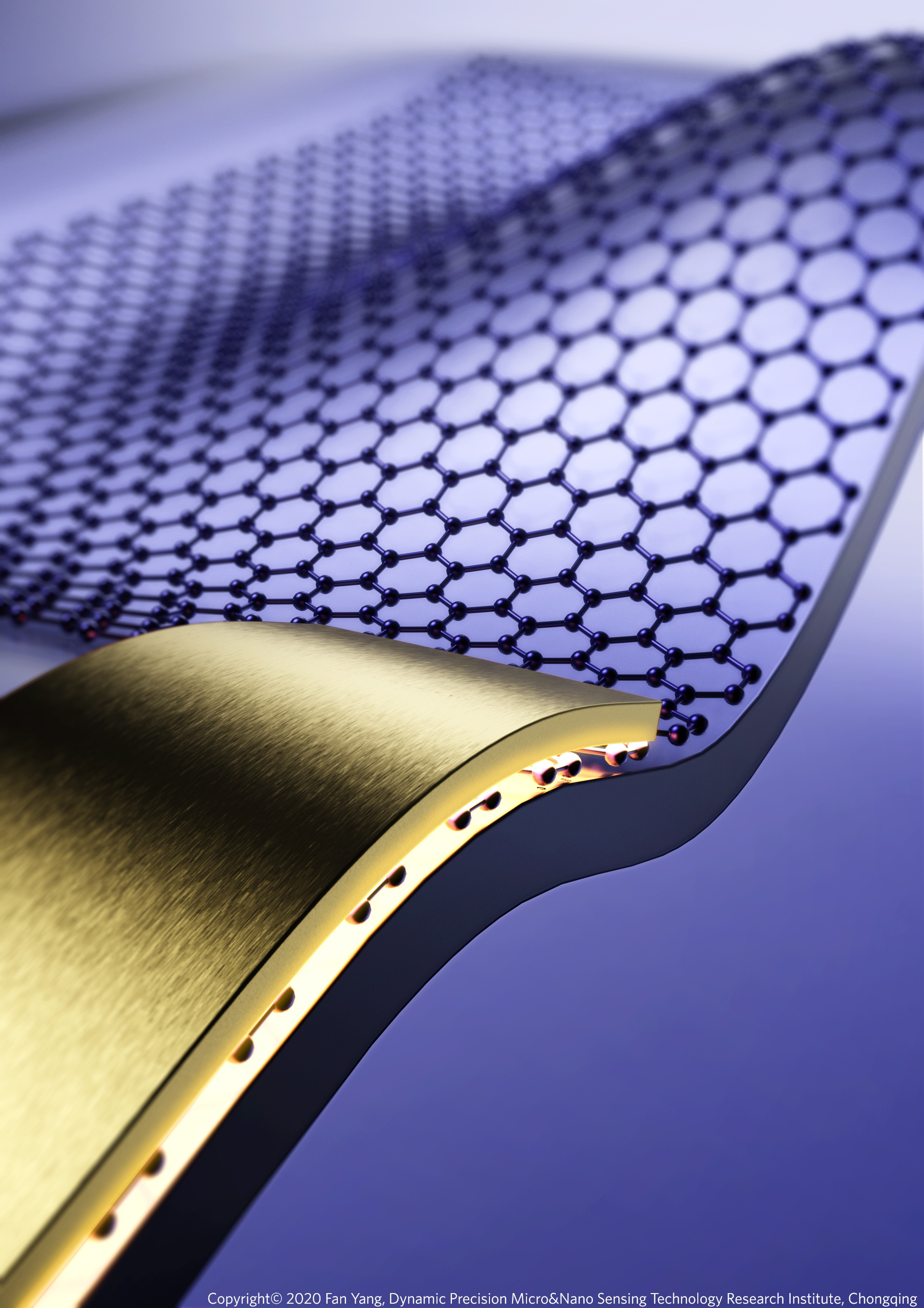Silicon-based MEMS/NEMS empowered by graphene: a scheme for large tunability and functionality
Published in Materials, Physics, and Mathematical & Computational Engineering Applications

Here, we experimentally demonstrate and theoretically analyze a powerful on-chip integration principle consisting of a hybrid graphene/silicon nitride membrane with metallic leads on top that enables an extremely large static and dynamic parameter regulation. When a static voltage is applied to the leads of the integrated structure, a spatially confined localized electrothermomechanical (ETM) effect results in ultra-wide frequency tuning, deformation (buckling transition) and regulation of the mechanical properties. Moreover, by injecting an alternating voltage to the leads, we can excite the resonator vibrating even far beyond its linear regime without a complex and space consuming actuation system. Our results prove that the scheme provides a compact integrated system possessing mechanical robustness, high controllability, and fast response. It not only expands the limit of the application range of MEMS/ NEMS devices, but also enables the further miniaturization of the device.
(https://www.nature.com/articles/s41378-025-00960-0)

Behind-the-scenes: We first observed the unique behavior of these MGS structures when applying higher voltages: the underlying silicon nitride freestanding membrane fractured mechanically rather than electrically. Given that nanofabricated silicon nitride is typically highly robust at nano- and micrometer scales, the substantial buckling force required for failure suggested an anomalous phenomenon that captured our attention. Through continuous observation using a white light interferometer—gradually increasing the applied voltage until membrane rupture—we recognized the involvement of the electrothermomechanical (ETM) effect. The buckling patterns revealed that the electrodes on the silicon nitride freestanding membrane played a critical role in this process.
Further investigation suggested that the graphene-metal interface generates significant heat, which remains spatially confined by the interface's geometric area. This concentrated ETM force serves as the fundamental mechanism enabling the structure's exceptional actuation and regulation capabilities. To validate this hypothesis, we integrated a single-layer hBN onto the metal lead above the graphene-metal interface; Raman spectral shifts indicated a temperature rise of approximately 100 K during buckling events. Subsequently, we conducted a series of experiments to characterize the ETM properties and regulatory capabilities of the MGS structures, ultimately concluding that this design concept can dramatically enhance the tunability and functionality of conventional silicon-based MEMS/NEMS devices.
Proposed ideas: Building upon the MGS structure's excellent performance in static deformation, eigenfrequency regulation, and surface-driven actuation, we propose several potential applications, including MGS micromirrors, microfluidic controllers, and AFM tips with integrated heating components.
In the case of micromirrors, the metal electrode deposited on the membrane acts as both a reflective surface for laser beams and a bending actuator. Applying a DC voltage enables static adjustment of the reflection angle, while an AC voltage facilitates high-frequency scanning for applications such as LIDAR. MGS-based devices offer several advantages for MEMS mirror applications. First, their inherently simpler structure allows for further miniaturization, as the same MGS component functions as both mirror and actuator. Second, the devices exhibit exceptionally fast response times, evidenced by on-chip excitation experiments demonstrating eigenfrequencies around 200 kHz—with potential for even higher frequencies in smaller resonators. For mirror applications, operating with low Q factors and near-critical damping proves advantageous by minimizing unwanted oscillations during state transitions. Third, these devices consume minimal power, as demonstrated in our manuscript. Power requirements can be further reduced by optimizing the SiN membrane's prestress, as predicted by our deformation threshold voltage model. Such rapidly controllable MEMS mirrors are currently in high demand for micro-optical systems.
Overall, this design combines the robustness of silicon-based materials with graphene's exceptional properties as an ultrathin conductor, significantly expanding tuning and deformation capabilities. By capitalizing on graphene's ultralow mass, minimal thickness, and high transparency, the SiN layer retains its superior mechanical (including low damping) and optical characteristics. Through exploitation of the electro-thermo-mechanical effect, we have achieved unprecedented eigenfrequency tuning (>50%), reversible spatial deflection, dynamic vibration control, and operation in nonlinear vibrational states for NEMS devices. This versatile concept promises to enable numerous applications, ultimately transforming the MEMS/NEMS technological landscape.
Dr. Fan Yang (on behalf of all authors)
In Chongqing, China.
Follow the Topic
-
Microsystems & Nanoengineering

This journal, with a target for a high-end journal for years to come, seeks to promote research on all aspects of microsystems and nanoengineering from fundamental to applied research.





Please sign in or register for FREE
If you are a registered user on Research Communities by Springer Nature, please sign in